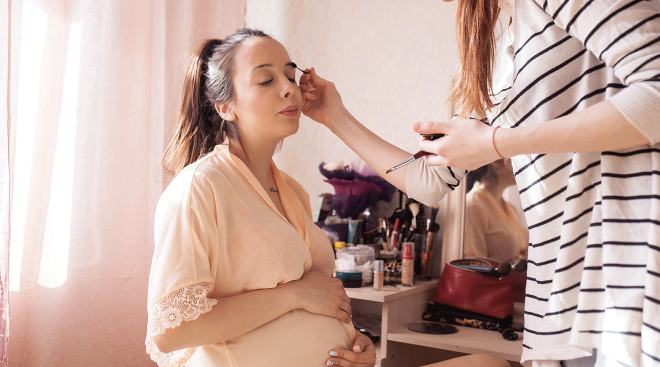- You’re in the home stretch of the first trimester! If you haven’t experienced any pregnancy symptoms yet, you might suddenly start noticing changes in your body—aches, pains and visible veins are all par for the course right now.
- Nope, it’s not a burrito baby. It’s a teeny-tiny starter bump. Noone else may notice it yet, but you probably won’t be able to keep your little secret for much longer.
- Your first prenatal visit has probably happened already (or will take place this week). In addition to an early ultrasound (and hearing and seeing baby’s heartbeat!), your doctor may discuss some potential options for a nuchal translucency screening and non-invasive prenatal testing. Both screen for chromosomal abnormalities.
Hello baby bump! Now that you’ve reached 10 weeks pregnant, you may stop wondering when you’ll start to actually look pregnant, because it’s probably right around now! Even more exciting? Baby is no longer an embryo—they’re officially considered a fetus. That means your 10 week fetus is becoming more and more baby-like, and you’re inching closer and closer to leaving the nasties of the first trimester behind you.
Week 10 of pregnancy is a milestone: Baby is no longer an embryo—they’re now a fetus! These two terms simply define different phases of development. The embryonic phase is about forming major organs, including the brain, heart and lungs, plus the arms and legs. Once you’ve got a fetus, those organs and parts are formed and are now growing and developing. At this stage, baby’s head has become rounder and makes up about half the length of their body. To give their brain room to develop, their forehead sports a bit of a bulge.
Goodbye, webbed fingers and toes. By now, baby’s hands and feet are fully formed, with their fingers and toes longer and their nails beginning to develop. They can bend their elbows for the first time with working arm joints, and cartilage and bones are forming. Fingernails and hair are starting to appear too! And can you believe baby is busy practicing swallowing and kicking inside your 10 weeks pregnant belly?
How big is baby at 10 weeks?
During week 10 of pregnancy, baby is as big as a strawberry or a green olive, measuring between 1 and 2 inches long and weighing about .25 ounces. Your 10 week fetus’s body length will almost double in the next three weeks. Wow!
10 weeks pregnant is how many months?
At 10 weeks pregnant, you’re about two months and two weeks pregnant—but remember, doctors prefer to track pregnancy by week, not by month. That’s because pregnancy is 40 weeks long, as calculated from the first day of your last period, and that adds up to more than nine months!
10 week ultrasound
Ten weeks is an important time if you’ve decided to have some first trimester genetic testing. Genetic testing is optional; which ones you choose to get—or not get—is up to you, but a genetic counselor can help you decide based on your family history and risk factors.
The nuchal translucency screening (aka NT Scan) typically happens between weeks 10 and 14; it tests your fetus for risk of Down syndrome and several other chromosomal abnormalities. For it, you’ll have a painless ultrasound, and baby’s nuchal fold (back of the neck) will be measured for signs of abnormality. The NTS is typically done as part of a “First Trimester Screen” where your blood is tested and your risk is assessed based on the results of both the ultrasound and the blood test.
A cell-free fetal DNA test, also known as a non-invasive prenatal test (NIPT), is a blood test drawn at week 10 or later. It screens mom’s blood for signs of risk for Down syndrome, Edward Syndrome, Patau Syndrome and other chromosomal abnormalities. Other, more invasive tests—the CVS and amniocentesis—can be used to diagnose abnormalities as well. They’re typically performed if you have a higher risk of having a baby with a chromosomal abnormality, whether based on family history, risk factors or NTS or NIPT results.
The CVS (chorionic villus sampling), performed between weeks 10 and 13, uses an ultrasound to determine the placenta’s location. Then, using ultrasound as a guide, the doctor inserts a needle through your belly or through the vagina while doing a speculum exam to collect cells from the placenta. Those cells are tested for genetic abnormalities.
If you opt for amniocentesis, you’ll schedule it for between weeks 15 and 20. Overwhelmed by all the first- and second-trimester testing? Trust us; once you’re done with it, you’ll be able to concentrate on more fun to-dos.
Wondering what to expect at 10 weeks pregnant? As baby grows, your ligaments and muscles are starting to stretch inside your 10 weeks pregnant belly, your breasts are getting bigger and some other radical changes may be happening. Here are some of the most common 10 weeks pregnant symptoms:
Round ligament pain
Don’t be surprised if you start feeling some aches and pains in your abdomen as it stretches to accommodate your growing baby. While some moms-to-be don’t really get or notice them, others find these sensations—called round ligament pain—well, downright painful. If you’re 10 weeks pregnant with twins, round ligament pain could be even more noticeable. Let your OB know if your discomfort is intense or if you’re worried in any way about your 10 weeks pregnant symptoms.
Growing breasts
Your breasts have probably gotten bigger and a bit sore by week 10 of pregnancy, since they’ve been prepping for breastfeeding for weeks already!
Morning sickness
Nausea and vomiting are pretty common at 10 weeks pregnant, and of course it’s not always in the morning. The good news is, they’ll likely subside soon after you hit the second trimester.
Mood swings
Changes in your hormones may be to blame for a roller coaster of emotions.
Fatigue
You’re zapped. Here’s why: Not only is your body working really hard to grow baby, but your sleep might be disrupted by some pretty weird dreams.
Increased vaginal discharge
An increased blood flow to your vagina coupled with an increase in estrogen production could cause more of a clear, odorless discharge called leukorrhea. It might seem a little gross, but this substance is simply nature’s way of getting rid of bacteria. If it’s colored, tinged with blood, has a foul odor or causes discomfort, however, call your doctor. Those could be signs of something else.
Visible veins
Those blue streaks are an important reminder: They’re a sign of all the extra blood circulating in your body for your growing baby! You may also see spider veins begin to appear because of the extra blood in your veins.
What you might feel like at 10 weeks pregnant
Do you find yourself wondering, "what should I feel like at 10 weeks pregnant?" The answer: tired and definitely pregnant. Two and a half months into your pregnancy, you're probably experiencing clear 10 weeks pregnant symptoms. You’re likely to feel exhausted, achy and all around hormonal. Sometimes you'll feel excited about the changes your body is going through, and other times you might feel frustrated. All of it is okay and perfectly normal.
Your 10 weeks pregnant belly is probably just starting to show. That’s because your baby is continuing their rapid growth and so your tummy has started to develop some extra curve. You still might not look pregnant to people you meet, but you might need some pants with a stretchy waistband and some loose-fitting tops right around 10 weeks pregnant.
Many doctors recommend gaining about one to five pounds during the first trimester for pregnant women of normal BMI. So you’re right on track if you find yourself having gained a few pounds at 10 weeks pregnant.
If you’re pregnant with twins, your doctor may recommend you gain about a pound per week in the first half of your pregnancy, which means you could have gained about 10 pounds by the time you’ve reached 10 weeks pregnant with twins. But don’t worry if you haven’t gained that much weight, or even if you’ve lost weight due to morning sickness. You’ll hopefully be able to put weight back on during the second trimester when the nausea decreases.
Can you have a baby bump at 10 weeks?
You absolutely can. One of the 10 weeks pregnant symptoms is tight waistbands and some roundness in your lower abdomen that you can’t suck in. Everyone shows differently, and your baby bump will vary with your particular body shape and size, and may also depend on the shape of your uterus. If this isn’t your first pregnancy, or you’re carrying multiples, you’re more likely to have a visible baby bump in your first trimester. If you’re not obviously pregnant yet, just wait—your belly will grow with time.
Can you feel baby at 10 weeks?
Everyone waits for that first telltale flutter from baby, so you might be asking, “can you feel baby at 10 weeks?” Even though baby is getting those practice kicks in, you’re unlikely to feel a 10 week fetus move before the second trimester, because those kicks and movements are just too small to sense at this early stage. Even if you don’t feel it quite yet, you can enjoy watching baby kick during your ultrasound!
Feeling moody? It’s normal and one of the many signs your body is producing those much-needed hormones! Grab some tissues, give yourself some grace and remember it’s really those hormones and not you!
Here’s what you can do to live your healthiest life during this exciting but stressful time.
Eat first thing to curb nausea
Nausea is often worse in the morning, hence the term “morning sickness.” Keep granola bars or saltine crackers by the bed so you can have a small snack before even getting up. You might find this helps keep morning sickness at bay.
Get your vitamins
You’re growing a whole new person, which means you’ll need to be good about taking your prenatal vitamin and consuming vitamin-rich foods. Vitamin D, C and A are particularly important, as is folic acid, DHA, iron, calcium and potassium.
Snack well
Eating the right foods helps you get the vitamins and minerals that you and your 10 week fetus need, and it can help you feel better too. Snacks high in potassium, like mangoes or bananas, can help with nausea, while the protein and essential nutrients in eggs and nuts offer a nutritional punch and help keep you from getting hangry.
Don’t push it
The list of 10 weeks pregnant symptoms feature exhaustion, dizziness, swinging emotions and strong reactions to smells, foods or sights. Your body is changing quickly, and you’re flooded with hormones. This means that your 10 weeks pregnant symptoms can run the gamut from mild to intense. Let your body tell you when to rest or slow down. Most of these symptoms should dissipate soon.
Frequently Asked Questions
How much water should I drink at this stage of pregnancy?
Throughout your pregnancy, you’ll need to take in more fluids to support your higher blood volume, baby’s circulation and your supply of amniotic fluid. Aim for 8 to 12 8 oz. cups of water daily, and just sip when you can. To remind yourself to hydrate, keep a large pitcher of water in the fridge or carry a water bottle with you. You can also consider adding fruit slices to your water to make it more appealing if plain old H20 isn’t cutting it.
What foods help curb morning sickness?
Ease nausea with small, bland meals (think crackers, cereal or oatmeal with fruit). You can also try sipping ginger or peppermint tea. You’ll probably want to avoid spicy, greasy foods for now. On the other hand, if that’s what your body is craving, go for it! Cravings, aversions and morning sickness can go hand in hand so eat what tastes good and settles your tummy. And, remember, this phase will pass soon enough (and if it doesn’t, talk to your doctor about other options!).
What types of prenatal screenings are typically recommended at the 10-week mark?
Between now and 13 weeks, your provider will likely recommend scheduling a first-trimester screening. This will include two tests, usually given at the same time: a maternal blood test and an ultrasound exam. The blood test measures two substances: pregnancy-associated plasma protein and human chorionic gonadotropin (hCG). The ultrasound—otherwise known as the nuchal translucency screening—measures the thickness of the space at the back of baby’s neck. When these results are combined and assessed together, your doctor will have a better chance of predicting whether baby is at a higher risk of having a genetic disorder, like Down syndrome (trisomy 21) or trisomy 18.
When will I be able to feel baby move?
At week 10, if you sense baby’s movement, it’s most likely just gas (sigh). That’s because quickening (feeling baby’s movement in the uterus) typically begins some time between 16 and 20 weeks. When it occurs, it will feel like bubbles, flutters or pulsing sensations.
When does the second trimester start?
You still have about a month to go. Technically, the second trimester begins at week 14 and lasts through week 27. With a typical pregnancy spanning 40 weeks, each trimester is roughly 14 weeks. That said, many consider week 12 the start of the second trimester, so you’ll encounter both ways of tracking a pregnancy.
We made sure to let our first daughter in on our news early. 'Your little sibling is in mommy's tummy. We are excited for you to become a big sister!' This helped to make her feel valued.
Please note: The Bump and the materials and information it contains are not intended to, and do not constitute, medical or other health advice or diagnosis and should not be used as such. You should always consult with a qualified physician or health professional about your specific circumstances.
American College of Obstetricians and Gynecologists, Nutrition During Pregnancy, June 2023
American College of Obstetricians and Gynecologists, Weight Gain During Pregnancy, January 2013
American Pregnancy Association, 10 Weeks Pregnant
American Pregnancy Association, Dizziness During Pregnancy
American Pregnancy Association, Fatigue During Pregnancy
American Pregnancy Association, Genetic Counseling
American Pregnancy Association, Pregnancy Dreams
American Pregnancy Association, Pregnancy Nutrition
American Pregnancy Association, Pregnancy Vitamins and Nutrition
American Pregnancy Association, Prenatal Tests
American Pregnancy Association, Uterus Size During Pregnancy
American Pregnancy Association, Your First Prenatal Visit
Cleveland Clinic, Chorionic Villus Sampling for Prenatal Diagnosis, June 2021
Cleveland Clinic, Fetal Development, March 2023
Cleveland Clinic, Nuchal Translucency Scan, June 2022
Cleveland Clinic, Quickening in Pregnancy, April 2022
Cleveland Clinic, Pregnancy: Second Trimester, November 2021
Cleveland Clinic, Round Ligament Pain, July 2021
Kaiser Permanente, Your Pregnancy: Weeks 9 to 12
March of Dimes, Amniocentesis, May 2017
March of Dimes, Common Discomforts of Pregnancy, March 2022
March of Dimes, Morning Sickness, September 2020
Mayo Clinic, 1st Trimester Pregnancy: What to Expect, March 2022
MayoClinic, Pregnancy Week by Week
Mayo Clinic, Fetal Development: The 1st Trimester, June 2022
Mayo Clinic, Symptoms of Pregnancy: What Happens First, December 2021
National Institutes of Health Office of Dietary Supplements, Omega-3 Fatty Acids, February 2023
National Institutes of Health Office of Dietary Supplements, Potassium, June 2022
Planned Parenthood, What Happens in the Third Month of Pregnancy?
Reviews in Obstetrics & Gynecology, Treatment of Hyperemesis Gravidarum, 2012
Texas Children’s Hospital, Changes During Pregnancy: What’s Normal and What’s Not?
Ultrasound in Medicine and Biology, Early Fetal Movements are Useful for Estimating the Gestational Weeks in the First Trimester of Pregnancy, 1983
University of California San Francisco, FAQ: Cell-Free DNA Screening
The Journal of Perinatal Education, Nutrition Column An Update on Water Needs during Pregnancy and Beyond, 2002
American College of Obstetricians and Gynecologists (ACOG), How much water should I drink during pregnancy?](https://www.acog.org/womens-health/experts-and-stories/ask-acog/how-much-water-should-i-drink-during-pregnancy),,) October 2020
American Pregnancy Association, Morning Sickness Remedies
American College of Obstetricians and Gynecologists (ACOG), Prenatal Genetic Screening Tests, November 2023
Johns Hopkins Medicine, Common Tests During Pregnancy
Learn how we ensure the accuracy of our content through our editorial and medical review process.
Navigate forward to interact with the calendar and select a date. Press the question mark key to get the keyboard shortcuts for changing dates.















































